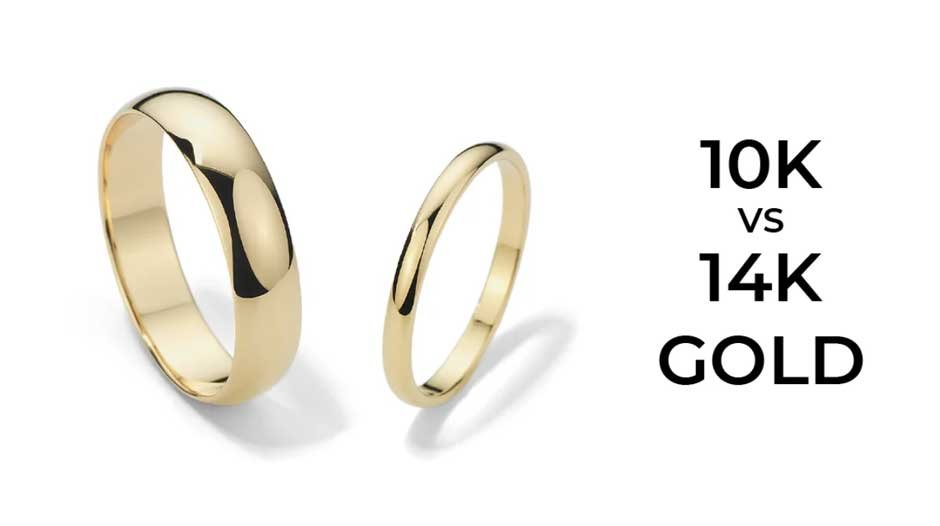When I first started buying gold jewelry, I was confused by the different karats. I wondered about the difference between 10k and 14k gold. After some thorough research, I learned that it’s all about the percentage of pure gold in the piece. Honestly, it made sense.
10k has less pure gold than 14k. This means 10k is more affordable and durable, but 14k looks a bit more luxurious. Again, it makes a whole lot of sense.
Knowing this helped me pick the right gold for my budget and style. Every time, right on the money. I hope sharing my experience makes it easier for you to choose the perfect gold jewelry too!
What is Gold Purity?
Before we dive into the specifics of 10k vs 14k gold, it’s essential to understand how gold purity is measured. Gold purity is expressed in karats (k), with 24k being pure gold. However, pure gold is too soft for jewelry, so it’s mixed with other metals to create alloys that are more durable and suitable for everyday wear.
The most common gold alloys used in jewelry are:
- 10k Gold: Contains 41.7% pure gold and 58.3% other metals
- 14k Gold: Contains 58.3% pure gold and 41.7% other metals
- 18k Gold: Contains 75% pure gold and 25% other metals
These alloys allow for a wider variety of jewelry designs, from classic hoops and timeless bangles to trendy jewelry styles, e.g., statement necklaces, and layered pendant combinations. They also open doors to incorporating stunning gemstones like diamonds, sapphires, or even moissanite, a dazzling and ethical alternative that’s gaining popularity not just in engagement rings but also in trendy pieces like moissanite earrings for men.
Durability: 10k vs 14k Gold
One of the main differences between 10k and 14k gold is durability. 10k gold contains a higher percentage of other metals, making it more durable and resistant to scratches and dents compared to 14k gold. This makes 10k gold an excellent choice for everyday wear, especially for pieces like rings and bracelets that are more prone to accidental bumps and scratches.
On the other hand, 14k gold is slightly softer due to its higher gold content. While still durable enough for daily wear, it may show signs of wear more quickly than 10k gold.
Appearance: 10k vs 14k Gold
Another factor to consider when comparing 10k and 14k gold is appearance. 14k gold has a richer, warmer yellow hue because of its higher percentage of pure gold. In contrast, 10k gold may appear slightly paler or have a subtle pinkish tint due to the higher copper content in its alloy.
However, the difference in color is less noticeable in white gold, as both 10k and 14k white gold are usually coated with rhodium for a bright, silvery finish.
Price Point: 10k vs 14k Gold
When it comes to affordability, 10k gold has the upper hand. Because it contains a lower percentage of pure gold, 10k gold is generally less expensive than 14k gold. This makes it an attractive option for those on a budget who still want to enjoy the beauty and prestige of gold jewelry.
Keep in mind that the price of gold fluctuates based on market conditions and can vary depending on the design and craftsmanship of the piece.
Skin Sensitivity: 10k vs 14k Gold
If you have sensitive skin or allergies to certain metals, the difference between 10k and 14k gold is crucial. 14k gold contains a higher percentage of pure gold, leaving less room for potentially irritating alloy metals like nickel. On the other hand, 10k gold contains a higher proportion of these alloys, which may lead to skin reactions in some individuals.
If you have a history of skin sensitivities, opting for 14k or higher purity gold can help minimize the risk of irritation.
Choosing Between 10k and 14k Gold
When deciding between 10k and 14k gold, consider the following factors:
- Intended Use: For everyday pieces like simple bands, chains, and earrings, 10k gold is a durable and affordable choice. For special occasions or heirloom pieces, 14k gold offers a luxurious appearance and higher purity.
- Budget: 10k gold is more budget-friendly, while 14k gold provides a balance between affordability and higher gold content.
- Skin Sensitivity: If you have sensitive skin, 14k gold or higher is a safer choice to minimize the risk of irritation.
- Personal Preference: Consider your personal style and the desired appearance of the jewelry. 14k gold has a richer, warmer color, while 10k gold may appear slightly paler.
Caring for Your Gold Jewelry
Regardless of whether you choose 10k or 14k gold, proper care and maintenance are essential to keep your jewelry looking its best. Follow these tips to care for your gold pieces:
- Remove jewelry before engaging in activities that may expose it to harsh chemicals, such as cleaning, swimming, or exercising.
- Store your gold jewelry separately to prevent scratches and tangles. Use a soft cloth pouch or a lined jewelry box with compartments.
- Clean your gold jewelry regularly using a mild soap solution and a soft-bristled brush. Rinse thoroughly and dry with a soft cloth.
- Have your gold jewelry professionally inspected and cleaned every 6-12 months to ensure that any potential issues, such as loose stones or clasps, are addressed promptly.
The Bottom Line
In summary, the main difference between 10k and 14k gold lies in their purity, which affects durability, appearance, price, and potential for skin irritation. 10k gold is more durable and affordable, making it ideal for everyday wear. 14k gold offers a richer color, higher purity, and less risk of allergic reactions, making it a popular choice for special occasions and sensitive skin.
When shopping for gold jewelry, consider your lifestyle, budget, personal preferences, and skin sensitivity to make the best choice between 10k and 14k gold. By understanding the key differences and caring for your jewelry properly, you can enjoy your beautiful gold pieces for years to come.







